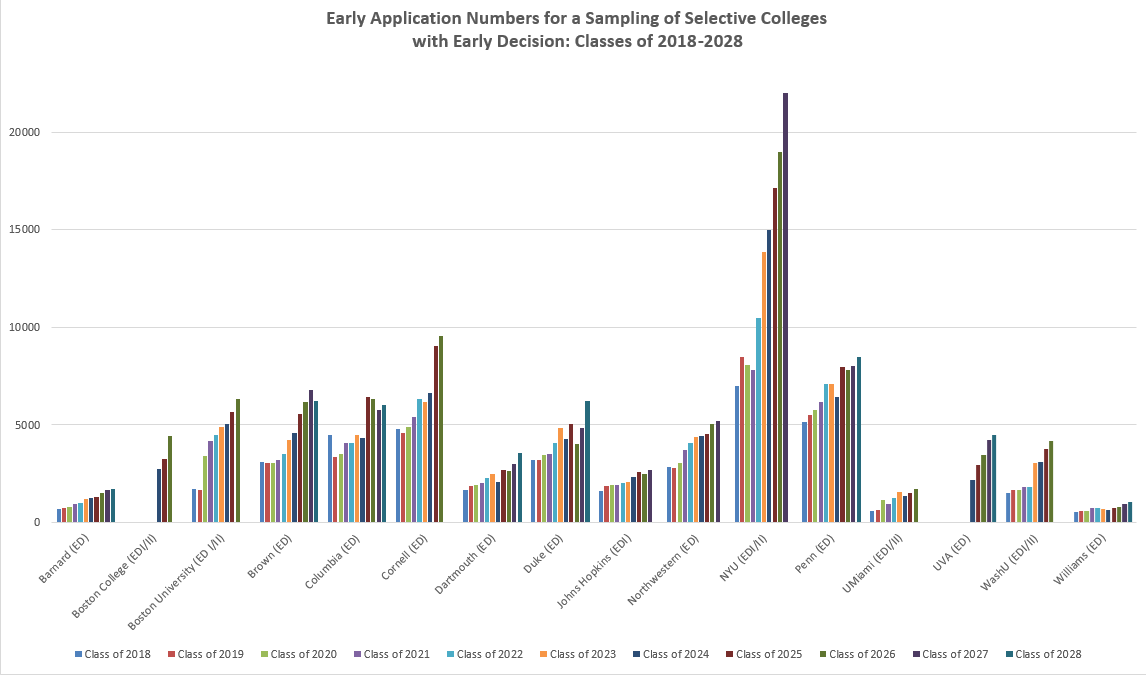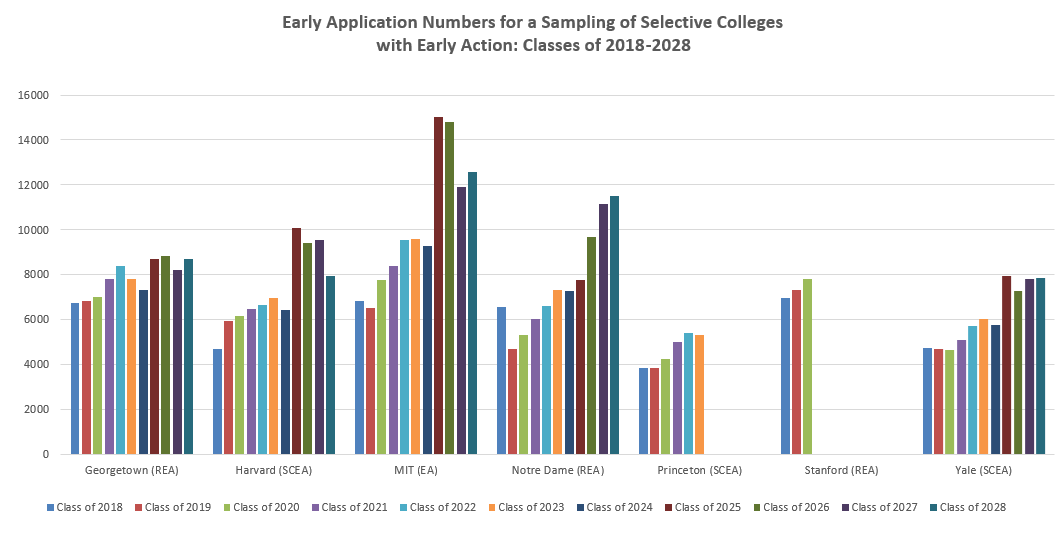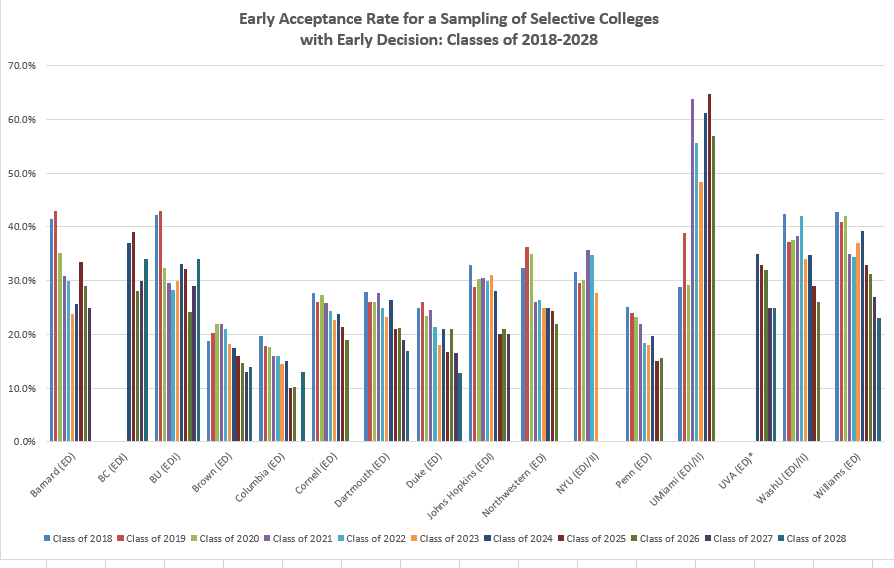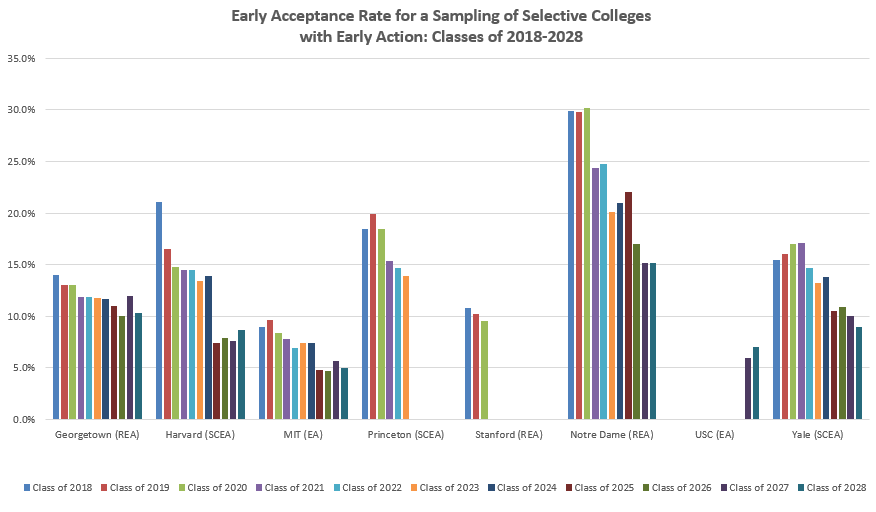 This is Part I of our series on Early Admissions for the Class of 2028. This post analyzes early application acceptance rates. For the Class of 2028, early applications continued to increase or hold steady at many highly selective schools, and as a result, early acceptance rates remained low or dropped further. This was the first admissions cycle following the Supreme Court’s ruling on race-conscious admissions policies. Most schools continued to offer test-optional admissions after the success of previous admissions cycles. Congratulations to all students who submitted early applications—your dedication will benefit you in the admissions process!
This is Part I of our series on Early Admissions for the Class of 2028. This post analyzes early application acceptance rates. For the Class of 2028, early applications continued to increase or hold steady at many highly selective schools, and as a result, early acceptance rates remained low or dropped further. This was the first admissions cycle following the Supreme Court’s ruling on race-conscious admissions policies. Most schools continued to offer test-optional admissions after the success of previous admissions cycles. Congratulations to all students who submitted early applications—your dedication will benefit you in the admissions process!
Whatever your early admissions outcomes, it is important to have an open mind and to maintain faith in the process of finding your best-fit school. In this blog post, we have put together an in-depth analysis of this year’s early admissions trends and statistics, as well as tips for future early applicants.
Stay tuned for the following posts in the series:
- Part II: Diversity in Early Admissions
- Part III: Deferral Stats
- Part IV: Who Benefits from Early Decision
- Part V: The Impact of Early Decision on Regular Decision Admissions
Overall Early Application Trends
Early admissions continues to soar, as more students apply through early decision application plans to demonstrate interest, increase their chances, and gain some certainty. Also, test-optional plans at selective schools could continue to encourage some students to try their luck at colleges which would otherwise seem out of reach.
Most selective schools experienced a slight rise in early application numbers that continue to be very high. Colleges that continue to break early application records and whose numbers rose from last year include Dartmouth (up 18%), Duke (up 28%), Emory (EDI up 12%), and Williams (up 13%). USC, which added Early Action to its admissions cycle for the first time last year, received a whopping 41,000 early apps this cycle! USC admitted 7% of EA applicants and deferred all applicants who were not accepted.
Colleges that continued to see high early application numbers that only rose slightly or stayed relatively flat compared to last year include Barnard, Georgetown, MIT, Notre Dame, Penn, Rice, Williams, and Yale.
Some schools did see a drop in early applications. For example, Brown’s ED apps fell by 8% and Harvard’s EA apps were down 17% from last year. But keep in mind that the decreases were from an already high volume of apps.
In general, ED acceptance rates have continued to decline. However, they remain significantly higher than Regular Decision acceptance rates. Several selective colleges broke school records with their low early acceptance rates, including Dartmouth (17%), Duke (12.9%), Williams (23%), and Yale (9%). In contrast, some schools saw a rise in early acceptance rates. Boston College (up 4%), Boston University (up 5%), and Harvard (up 1.1%).
Many schools had early acceptance rates that remained constant compared to last year. This year, UVA’s ED acceptance rate included a 30% in-state admit rate and an 18.5% out-of-state admit rate, which was very similar to last year.
Overall Early Application Numbers
The following bar graphs compare early admissions application numbers and acceptance rates for the Class of 2018 through 2028 – for colleges with Early Decision and with Early Action. As a refresher, Early Decision (ED) is binding and mandates enrollment; Single Choice Early Action (SCEA) and Restrictive Early Action (REA) are restrictive but allow the student to wait until May 1st to decide; and Early Action (EA) is unrestrictive and non-binding. Early Decision is typically associated with higher acceptance rates because the school is guaranteed the student’s enrollment, which increases the yield factor, and results in a class comprised of students who have demonstrated a high degree of interest.
Early Admissions Statistics for a Sampling of Selective Colleges
*BC and UVA began ED programs in 2019
*Notre Dame changed its early admissions program from EA to REA in 2015.
*Princeton stopped releasing early stats in 2020, and Stanford ceased releasing early stats in 2017.
*USC began its EA program in 2022.
Our Tips
We recognize that the process of waiting for your admissions results can be very challenging. Here are our tips to seniors for maximizing your chances.
FOR SENIORS:
If you have been accepted ED, withdraw all other applications and continue to engage in your academics.
If you have been deferred or denied from your top early admissions choice:
- Send your #1 college (if you have a top choice) a Letter of Intent saying that you would attend if accepted.
- Send your other early admission colleges Letters of Continued Interest with updates about academics and activities. For RD admissions, you could send the letter by early March. Typically, it’s fine to send up to two letters if you space them out by at least three weeks and have significant new information to share.
- Continue to engage in your academics; colleges want to see your midyear report and final report card.
- Visit (or revisit) colleges in which you are most interested.
- Keep a positive outlook and have faith in the process!
FOR JUNIORS:
If you are weighing early application choices, please keep the following in mind:
- Consider schools that cover a wide range of admissibility, from reach to target to safe schools, to ensure that you have a wonderful set of options.
- Only apply Early Decision if you are fully committed to attending the school.
- Apply Early Action or by an earlier Priority Deadline, if you want to increase your chances for merit scholarship opportunities.
- Begin by researching schools online, looking at school websites to understand their programs and taking notes.
- Get organized the summer before your senior year by writing your Personal Essay while you are not in school and visiting colleges early to get a better sense of your “best-fit” features.
Deciding whether and where to apply early can be daunting, especially now. But whatever your question, Collegiate Gateway is happy to help you decipher your options and understand the changing landscape of early admissions.




